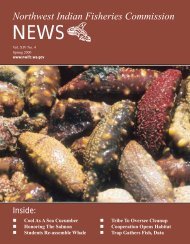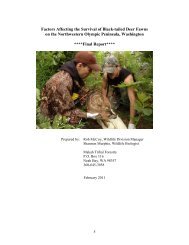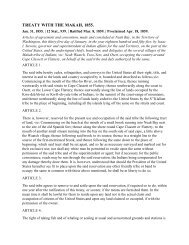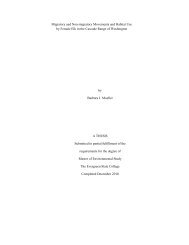Draft TRT Document â for Discussion Purposes ... - NWIFC Access
Draft TRT Document â for Discussion Purposes ... - NWIFC Access
Draft TRT Document â for Discussion Purposes ... - NWIFC Access
You also want an ePaper? Increase the reach of your titles
YUMPU automatically turns print PDFs into web optimized ePapers that Google loves.
<strong>Draft</strong> <strong>TRT</strong> <strong>Document</strong> – <strong>for</strong> <strong>Discussion</strong> <strong>Purposes</strong> – OK to circulatesteelhead predominate (Dan Rawding, WDFW, Vancouver, Washington, personalcommunication).In 1900, a study by the Smithsonian Institution reported that steelhead begin toreturning to fresh water as early as November, but that the principal river fisheriesoccurred in January, February, and March, when “the fish are in excellent condition”(Rathbun 1900). The average weight of returning steelhead was 3.6 to 6.8 kg (8 to 15lb.), although fish weighing 11.4 kg (25 lb.) or more were reported. The principalfisheries were in the Skagit River Basin, although in “nearly all other rivers of any sizethe species seems to be taken in greater or less quantities (Rathbun 1900).” Thespawning season of (winter-run) steelhead was described as occurring in the early spring,but possibly beginning in the latter part of winter.In<strong>for</strong>mation on summer-run steelhead in Puget Sound is very limited. In fact, inits 1898 report, the Washington State Fish Commission concluded that the ColumbiaRiver was “the only stream in the world to contain two distinct varieties of Steel-heads”(Little 1898). Little (1898) did indicate; however, that the winter run of steelheadcontinued from December through the first of May and overlapping runs of winter- andsummer-run steelhead may have been considered a single population. Evermann andMeek (1898) reported that B.A. Alexander examined a number of steelhead caught nearSeattle in January 1897, and that the fish were in various stages of maturation: “a few fishwere spent, but the majority were well advanced and would have spawned in a shorttime.” Returning steelhead were historically harvested from December through February,using in-river fish traps rather than trolling in salt water (Gunther 1927).Much of the early life-history in<strong>for</strong>mation comes from the collection andspawning of steelhead intercepted at hatchery weirs. The U.S. Fish CommissionHatchery at Baker Lake initially collected steelhead returning to Baker Lake usinggillnets. Fish were collected from 9 March to 8 May, few survived to spawn, and nospawning date was given (USDF 1900). Later attempts to collect fish from Phinney[Finney] and Grandy creeks in March met with limited success, based on a survey ofthese creeks and the Skagit it was concluded that much of the run entered the rivers inJanuary (Ravenel 1902). During the first years of operation of the Baker Dam, 1929-1931, steelhead were passed above the dam from April to July. Peak entry to the damtrap occurred during April. Although a relatively large number of fish were spawned inMay 1931 (51 fish), on 15 June 1931, when spawning operations had ceased, 92 “green”(unripe) fish were passed over the dam (Harisberger 1931). It is unclear if these fishwould have spawned in late June or July, or if they would have held in fresh water untilthe next spring (e.g. summer run steelhead). Riseland (1907) reported that the SaukRiver Hatchery collected steelhead spawn from the first part of February until the 15 th ofJune. Steelhead were spawned at the Quilcene National Fish Hatchery in Hood Canalfrom 27 February to 7 June 1922 (USBF 1923). Stream survey reports <strong>for</strong> Hood Canalindicated that the steelhead spawn during the late winter and early spring (WDF 1932). Itshould be noted that this spawning time was only noted <strong>for</strong> tributaries on the east side ofHood Canal (Dewatto Creek, Tahuyeh [sic] River, Big Beef Creek) or smaller tributarieson the west side of Hood Canal (Jorsted Creek, Little Quilcene River, Little LilliwaupCreek), larger tributaries were generally too turbid to survey. These larger rivers36









